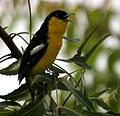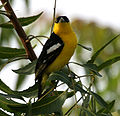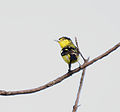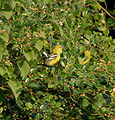- Common Iora
-
Common Iora 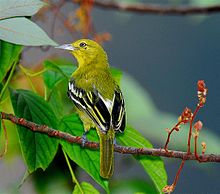
Conservation status Scientific classification Kingdom: Animalia Phylum: Chordata Class: Aves Order: Passeriformes Family: Aegithinidae Genus: Aegithina Species: A. tiphia Binomial name Aegithina tiphia
(Linnaeus, 1758)The Common Iora (Aegithina tiphia) is a small passerine bird found across the tropical Indian Subcontinent with populations showing plumage variations, some of which are designated as subspecies. A species found in scrub and forest, it is easily detected from its loud whistles and the bright colours. During the breeding season, males display by fluffing up their feathers and spiral in the air appearing like a green, black, yellow and white ball.
Contents
Description
Ioras have a pointed and notched beak with a culmen that is straight. The Common Iora is sexually dimorphic, males in the breeding season have a black cap and back adding to a black wing and tail at all seasons. Females have greenish wings and an olive tail. The undersides of both are yellow and the two white bars on the wings of the male are particularly prominent in their breeding plumage. The males in breeding plumage have a very variable distribution of the black on the upperparts and can be confused with Marshall's Iora, however, the latter always has white tips to the tail.[2] The nominate subspecies is found along the Himalayas and males of this population are very similar to females or have only a small amount of black on the crown. In northwestern India, septentrionalis is brighter yellow than others and in the northern plains of India humei males in breeding plumage have a black cap and olive on the upper mantle. In southwestern India and Sri Lanka multicolor has the breeding males with a jet black cap and mantle. The forms in the rest of southern India are intermediate between multicolor and humei with more grey-green on the rump (formerly considered as deignani but now used for the Burmese population).[2][3][4][5]
Several other populations across Southeast Asia are designated as subspecies including philipi of southern China and northern Thailand/Laos, deignani of Myanmar, horizoptera of southern Myanmar and the island chain of Sumatra, cambodiana of Cambodia, aeqanimis of Palawan and northern Borneo, viridis of Borneo and scapularis of Java and Bali.[6][7]
Behaviour and ecology
 Call of Common Iora (help·info) Ioras forage in trees in small groups, gleaning among the branches for insects. They sometimes join mixed species feeding flocks. The call is a mixture of churrs, chattering and whistles, and the song is a trilled wheeeee-tee. They may sometimes imitate the calls of other birds such as drongos.[8]
Call of Common Iora (help·info) Ioras forage in trees in small groups, gleaning among the branches for insects. They sometimes join mixed species feeding flocks. The call is a mixture of churrs, chattering and whistles, and the song is a trilled wheeeee-tee. They may sometimes imitate the calls of other birds such as drongos.[8]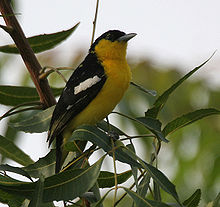 A. t. multicolor- Male in Hyderabad, India.
A. t. multicolor- Male in Hyderabad, India.
During the breeding season, mainly after the monsoons, the male performs an acrobatic courtship display, darting up into the air fluffing up all his feathers, especially those on the pale green rump, then spiralling down to the original perch. Once he lands, he spreads his tail and droops his wings.[3] Two to four greenish white eggs are laid in a small and compact cup-shaped nest made out of grass and bound with cobwebs and placed in the fork of a tree. Both male and female incubate[9] and eggs hatch after about 14 days. Nests predators include snakes, lizards, crow-pheasant and crows.[10] Nests may also be brood-parasitized by the Banded Bay Cuckoo.[11]
Ioras moult twice in a year and the plumage variation makes them somewhat complicated for plumage based separation of the populations.[11]
A species of Haemoproteus, H. aethiginae, was described from a specimen of the Common Iora from Goa.[12]
-
A. t. multicolor- Male calling in Hyderabad, India.
-
A. t. multicolor- Male in Hyderabad, India.
-
A. t. multicolor- Male in Hyderabad, India.
-
A. t. multicolor- Female in Hyderabad, India.
-
A. t. multicolor- Female in Hyderabad, India.
-
A. t. multicolor- Female in Narsapur, Medak district, India.
-
A. t. multicolor- Male in Hyderabad, India.
-
A. t. multicolor- Female in Narsapur, Medak district, India.
-
A. t. multicolor- Male calling in Shamirpet, Rangareddy district, Andhra Pradesh, India.
-
Adult breeding male - Singapore
-
Adult breeding male - Singapore
References
- ^ BirdLife International (2009). "Aegithina tiphia". IUCN Red List of Threatened Species. Version 2009.2. International Union for Conservation of Nature. http://www.iucnredlist.org/apps/redlist/details/147021.
- ^ a b Rasmussen PC & JC Anderton (2005). Birds of South Asia: The Ripley Guide. Volume 2. Smithsonian Institution & Lynx Edicions. pp. 344–346.
- ^ a b Baker, ECS (1922). Fauna of British India. Birds. Volume 1 (2 ed.). Taylor and Francis, London. pp. 339–343. http://www.archive.org/stream/faunaofbritishin01bake#page/339/mode/1up.
- ^ Wells, D.R., E.C. Dickinson & R.W.R.J. Dekker (2003). "Systematic notes on Asian birds. 34. A preliminary review of the Aegithinidae". Zool. Verh. Leiden 344: 7–15. http://www.repository.naturalis.nl/document/46744.
- ^ Dickinson, E.C., R.W.R.J. Dekker, S. Eck & S. Somadikarta (2003). "Systematic notes on Asian birds. 35. Types of the Aegithinidae". Zool. Verh. Leiden 344: 17–24. http://www.naturalis.nl/sites/naturalis.en/contents/i000308/snab035.pdf.
- ^ Mayr E & JC Greenway, ed (1960). Check-list of the birds of the world. Volume 9. Museum of Comparative Zoology, Massachusetts. pp. 300–302. http://www.archive.org/stream/checklistofbirds91960pete#page/300/mode/1up/.
- ^ Marien, D (1952). "The systematics of Aegithina nigrolutea and Aegithina tiphia (Aves, Irenidae)". Am. Mus. Novit. 1589: 1–17. hdl:2246/4066.
- ^ Bharos, A. M. K. (1998). "Mimicry by common Iora Aegithina tiphia". J. Bombay Nat. Hist. Soc. 95 (1): 116.
- ^ Wesley,H Daniel (1984). "Frequency and duration of incubation of the eggs for Aegithina tiphia". J. Bombay Nat. Hist. Soc. 81 (1): 193–195.
- ^ Ali,S (1931). "Casualties among the eggs and young of small birds". J. Bombay Nat. Hist. Soc. 34 (4): 1062–1067.
- ^ a b Ali, S & SD Ripley (1996). Handbook of the Birds of India and Pakistan. Volume 6 (2 ed.). Oxford University Press. pp. 47–54.
- ^ de Mello, I. (1935). "New hæmoproteids of some Indian birds". Proceedings: Plant Sciences 2 (5): 469–475. doi:10.1007/BF03053034.
External links
- BirdLife Species Factsheet
- Common Iora videos, photos & sounds on the Internet Bird Collection
Categories:- IUCN Red List least concern species
- Aegithina
- Birds of Asia
- Birds of Bangladesh
- Birds of Bhutan
- Birds of Brunei
- Birds of Cambodia
- Birds of China
- Birds of India
- Birds of Indonesia
- Birds of Laos
- Birds of Malaysia
- Birds of Burma
- Birds of Nepal
- Birds of Pakistan
- Birds of the Philippines
- Birds of Singapore
- Birds of Sri Lanka
- Birds of Thailand
- Birds of Vietnam
-
Wikimedia Foundation. 2010.


